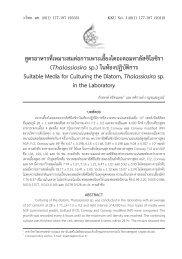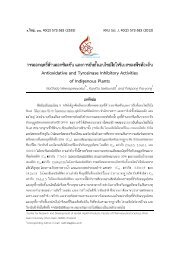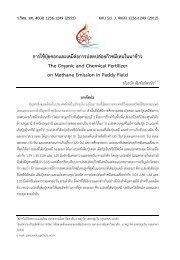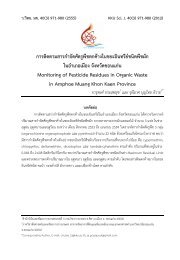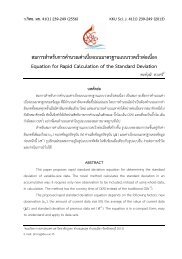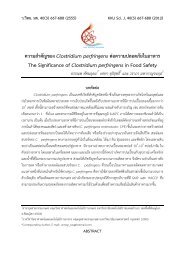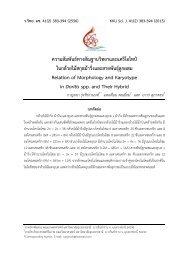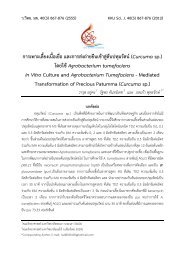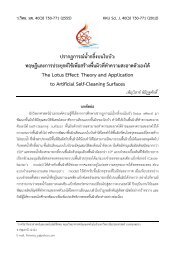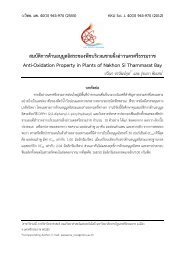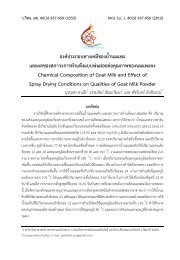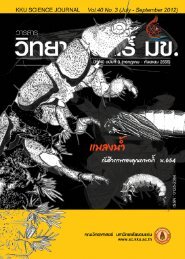Review
Review
Review
You also want an ePaper? Increase the reach of your titles
YUMPU automatically turns print PDFs into web optimized ePapers that Google loves.
∫∑§«“¡<br />
«“√ “√«‘∑¬“»“ µ√å ¡¢. ªï∑’Ë 39 ©∫—∫∑’Ë 1 49<br />
‡Õ° “√Õâ“ßÕ‘ß<br />
Aaker, D. and Ohta, Y. (1999). Production of<br />
Canthaxanthin by Extremely Halophilic<br />
Bacteria. J. Bioscience Bioeng. 88(6): 617-<br />
621.<br />
Aaker, D., Awad, T. and Ohta, Y. (2002). Lipids of<br />
Haloferax alexandrinus Strain TMT:<br />
an Extremely Halophilic Canthaxanthin-<br />
Producing Archaeon. J. Bioscience Bioeng.<br />
93(1): 37-43.<br />
Bertrand, J. C., Almallah, M., Acquaviva, M.,<br />
and Mille, G. (1990). Biodegradation of<br />
hydrocarbons by an extremely halophilic<br />
archaebacterium. Lett. Appl. Microbiol. 11:<br />
260-263.<br />
Boutaiba, S., Bhatnagar, T., Hacene, H., Mitchell,<br />
D. A. and Baratti, J. C. (2006). Preliminary<br />
characterisation of a lipolytic activity from<br />
an extremely halophilic archaeon,<br />
Natronococcus sp. J. Mol. Catalysis B:<br />
Enzymatic. 41 (1-2): 21-26.<br />
Bramley, P. M. (2000). Is lycopene beneficient to<br />
human health. Phytochem. 54: 233-236.<br />
Calo, P., de Miguel, T., Sieiro, C., Velazquez, J. B.<br />
and Villa, T. G. (1995). Ketocarotenoids in<br />
halobacteria: 3-hydroxyechinenone and<br />
trans-astaxanthin. J. Appl. Bacteriol. 79: 282-<br />
285.<br />
Capiralla, H., Hiroi, T., Hirokawa, T., and Maeda,<br />
S. (2002). Purification and characterizat<br />
ion of a hydrophobic amino acid-specific<br />
endopeptidase from Halobacterium halobium<br />
S9 with potential application in debittering<br />
of protein hydrolysates. Process Biochem.<br />
38: 571-579.<br />
Chen, C. W., Don, T. M. and Yen, H. F. (2006).<br />
Enzymatic extruded starch as a carbon<br />
source for the production of poly<br />
(3-hydroxybutyrate-co- 3-hydroxyvalerate)<br />
by Haloferax mediterranei. Process Biochem.<br />
41: 2289-2296.<br />
Christian, J. H. B. and Waltho, J. A. (1962). Solute<br />
concentrations within cells of halophilic and<br />
non-halophilic bacteria. Biochim. Biophys.<br />
Acta. 65: 506-508.<br />
Choi, J. I. and Lee, S. Y. (1997). Process analysis<br />
and economic evaluation for poly<br />
(3- hydroxybutyrate) production by<br />
fermentation. Bioprocess Eng. 17: 335-342.<br />
Don, T. M., Chen. C. W. and Chan, T. H. (2006).<br />
Preparation and characterization of<br />
6 poly(hydroxyalkanoate) from the<br />
fermentation of Haloferax mediterranei.<br />
J Biomater Sci Polymer Edn. 17: 1425-1438.<br />
Ghasemi, M. F., Shodjai-Arani, A. and Moazam, N.<br />
(2008). Optimization of bacteriorhodopsin<br />
production by Halobacterium salinarium<br />
PTCC 1685. Process Biochem. 43: 1077-<br />
1082.<br />
Grant, W. D., and Larsen, H. (1990). Extremely<br />
halophilic archaeobacteria, order<br />
Halobacteriales ord. nov., In: Staley, J. T.,<br />
Bryant, M. P., Pfennig, N., and Holt, J. G.<br />
(Eds.), Bergeyûs manual of systematic<br />
bacteriology, Vol. 3. Baltimore: Williams &<br />
Wilkins. pp. 2216-2233.<br />
Grout, M. J. (2000). Application of bacteriorhodopsin<br />
for optical limiting eye protection flters.<br />
Optical Materials. 14: 155-160.<br />
Hezayen, F. F., Alexander Steinbυchel, ¨ A. and<br />
Rehm, B. H. A. (2002). Biochemical and



